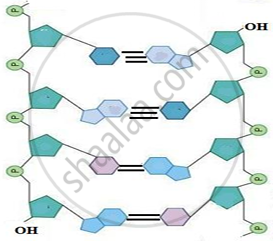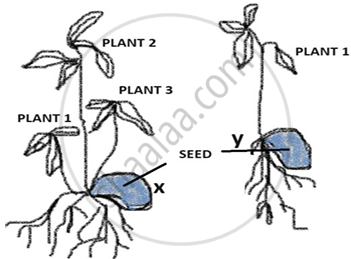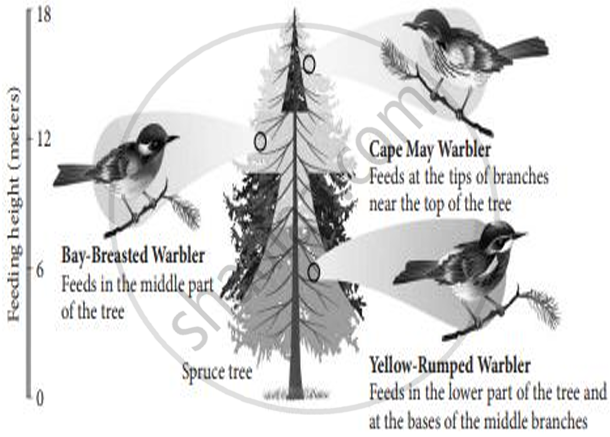Science (English Medium)
Academic Year: 2024-2025
Date: मार्च 2025
Advertisements
General Instructions:
- All questions are compulsory.
- The question paper has five sections and 33 questions.
- Section-A has 16 questions of 1 mark each; Section-B has 5 questions of 2 marks each; Section-C has 7 questions of 3 marks each; Section-D has 2 case-based questions of 4 marks each; and Section-E has 3 questions of 5 marks each.
- There is no overall choice. However, internal choices have been provided in some questions. A student has to attempt only one of the alternatives in such questions.
- Wherever necessary, neat and properly labeled diagrams should be drawn.
Signals for parturition in human female originate from ______.
Fully developed foetus only
Both placenta as well as fully developed foetus
Placenta only
Oxytocin released from maternal pituitary
Chapter:
To produce 1600 seeds, the number of meiotic divisions required will be ______.
2400
2000
1600
1800
Chapter:
A sample of normal double-stranded DNA was found to have thymine content of 27%. What will be the expected proportion of guanine in this strand?
23%
32%
36%
73%
Chapter:
Observe the schematic diagram that depicts a small section of nucleic acid. The bases in two strands are paired through hydrogen bonds that are shown by the dark lines. Identify the correct sequence of nucleotide in the 5’-3’ direction.

GCAT
CGTA
TAGC
ATCG
Chapter:
Suresh and Rajesh have defective haemoglobin due to genetic disorders. In Suresh, the problem is qualitative as he is having incorrectly functioning globin molecules while in Rajesh the problem is quantitative as he is having very few globin molecules. Identify the disorder they are suffering from.
| Suresh | Rajesh |
| Thalassemia - Autosomal Dominant blood disorder | Sickle Cell Anaemia - Autosomal linked Recessive trait |
| Suresh | Rajesh |
| Sickle Cell Anaemia - Autosomal linked Dominant trait | Thalassemia - Autosomal Recessive blood disorder |
| Suresh | Rajesh |
| Sickle Cell Anaemia – Autosomal linked Recessive trait | Thalassemia – Autosomal Recessive blood disorder |
| Suresh | Rajesh |
| Thalassemia - Autosomal Dominant blood disorder | Sickle Cell Anaemia - Autosomal linked Dominant trait |
Chapter:
In E.coli, the lac operon gets switched on when lactose is ______.
present in the medium and it binds to the repressor.
not present in the medium and the repressor binds to the operator.
not present in the medium and RNA polymerase binds to the operator.
Active lactose present in the medium binds to RNA polymerase.
Chapter:
Which of the following features shows the mechanism of sex determination in honey-bee?
- An offspring formed from the union of a sperm and egg develops as a female.
- Males have half the number of chromosomes than that of female.
- The males are haploid having 32 chromosomes.
- All workers and males are diploid having 16 chromosomes.
(i) and (ii)
(ii) and (iii)
(i) and (iv)
(ii) and (iv)
Chapter:
The following diagram shows a fragment of DNA which is going to be transcribed, the upper strand with polarity 3’ to 5’ is the template strand:
3´ ATTGCC 5´
5´ TAACGG 3´
After transcription the mRNA can be represented by ______.
5´ AUUGCC 3´
5´ AUUGCC 3’
5´ UAACGG 3´
5´ GGCAAU 3´
Chapter:
Idli - dosa dough rises due to production of which of the following gas?
CO
CO2
NO
NO2
Chapter:
Adaptive radiation leads to which of the following?
Increased competition among species
Decreased speciation rates
Limited morphological diversity among species
Rapid divergence of traits among populations inhabiting a given geographical area.
Chapter:
Eco R1 cuts the DNA between bases G and A only when the sequence of GAATTC is present. The number of nucleotides present in the resultant sticky ends that will be formed in each of the two strands of DNA after this enzyme cuts the DNA will be ______.
| Vector DNA | Foreign DNA |
| 1 & 5 | 5 & 1 |
| Vector DNA | Foreign DNA |
| 2 & 4 | 4 & 2 |
| Vector DNA | Foreign DNA |
| 2 & 5 | 5 & |
| Vector DNA | Foreign DNA |
| 3 & 4 | 4 & 3 |
Chapter:
During the secondary treatment of sewage, which of the following change in the effluent occur due to flocs?
Reduction in BOD
Increase in BOD
Decrease in DO
No change in DO or BOD
Chapter:
Assertion (A): Cells of tapetum have more than one nucleus.
Reason (R): They undergo meiosis without cytokinesis.
Both A and R are true and R is the correct explanation of A.
Both A and R are true and R is not the correct explanation of A.
A is true but R is false.
A is False but R is true.
Chapter:
Assertion (A): Deoxyribonucleoside triphosphates serve dual purposes.
Reason (R): They act as proof readers and provide energy.
Both A and R are true and R is the correct explanation of A.
Both A and R are true and R is not the correct explanation of A.
A is true but R is false.
A is False but R is true.
Chapter:
Assertion (A): A floating cover placed over the slurry in a biogas plant keeps on rising.
Reason (R): This cover keeps on rising due to the gas produced in the tank by the microbial activity.
Both A and R are true and R is the correct explanation of A.
Both A and R are true and R is not the correct explanation of A.
A is true but R is false.
A is False but R is true.
Chapter:
Assertion (A): DNA fragments can be isolated by Gel electrophoresis on the basis of their size.
Reason (R): The larger the fragment size, the faster it moves.
Both A and R are true and R is the correct explanation of A.
Both A and R are true and R is not the correct explanation of A.
A is true but R is false.
A is False but R is true.
Chapter:
A blood test reported negative for hCG.
- What does negative hCG imply?
- Name the tissue which produces hCG?
Chapter:
If a blood test reported positive for hCG in a person, then which other hormones would also be secreted by the tissue secreting hCG?
Chapter:
Advertisements
The human male ejaculates about 200 to 300 million sperm during a coitus, however the ovum is fertilized by only one sperm. How does the ovum block the entry of additional sperms?
Chapter:
All copulations will not lead to fertilization. Why?
Chapter:
The schematic representation given below shows a DNA strand and two types of mutations in the DNA strand.
| Original template | A | U | G | C | A | G | A | C | A | U | C | U | U | A | G |
| Met | Gln | Thr | Ser | Stop | |||||||||||
| Mutation I | A | U | G | A | A | G | A | C | A | U | C | U | U | A | G |
| Met | Lys | Thr | Ser | Stop | |||||||||||
| Mutation II | A | U | G | A | G | A | C | A | U | C | U | U | A | G | |
| Met | Arg | His | Leu | ||||||||||||
- Identify the type of mutation exhibited in I and II.
- Which of the above mutation is more harmful? Give reason.
Chapter:
Given below is a schematic representation of a mRNA strand

- In the above sequence, identify the translational unit in mRNA.
- Where are UTRs found and what is their significance?
Chapter:
Given below is the relationship between the HIV levels in the blood and helper T cell count in a person detected with AIDS. Study the relationship and answer the questions that follow.

- What kind of relationship is observed in the virus levels and the immune response after some days of the initial infection?
- Does it completely clear the virus from the body permanently? Give reason for your answer.
Chapter:
A culture plate of Lactobacillus shows blue-coloured colonies and colourless colonies. Explain the principle involved in the formation of such variance in the colour of colonies.
Chapter:
It was estimated that if an evergreen forest has a GPP of 400 J/m2/day and 150 J/m2/day worth of carbon dioxide flows out of that forest, what is the NPP in that forest?
Chapter:
Explain why pyramids of energy must always be upright.
Chapter:
Assume that, GPP Forest A = GPP Forest B = GPP Forest C, If Forest A has NPP = 1254 J/m2/day; Forest B, NPP = 2157 J/m2/day; and Forest C, NPP = 779 J/m2/day, which one of these forests has maximum energy loss by respiration? Give reason.
Chapter:
Draw an ecological pyramid of the number of the following food chains.
Tree — Insects — Woodpecker
Chapter:
Draw an ecological pyramid of the number of the following food chains.
Tree — Insects — Woodpecker
Chapter:
The image below shows two germinated seeds X and Y which belong to the same species. Seed X is produced by apomixis whereas seed Y is a product of sexual reproduction.

- Write the number of embryo(s), embryo sac(s) and ovules in the ovary of seed X.
- How multiples embryos are formed in citrus fruits?
- What advantage will plants developed from seed Y have over seed X?
Chapter:
Name the place in human ovary where the first meiotic division is completed during oogenesis. What are the products of this division? Give the chromosome number of each type of cells involved in the process.
Chapter:
The schematic representation given below shows the concept of Central Dogma.

- During the process of replication and transcription, the pairing of nitrogenous bases is not similar. Explain.
- How is the above process modified in a retrovirus? Name the process.
- Justify why during the process of transcription only a segment of DNA is copied into RNA.
Chapter:
Describe the steps involved in Southern blot hybridization using radiolabeled VNTR as a probe.
Chapter:
Bio-fertilisers are organisms that enrich the nutrient quality in the soil. Explain the role of three main sources of bio-fertilisers.
Chapter:
Advertisements
Explain how PCR technique can be used for amplification of a small amount of DNA template.
Chapter:
- Diagram given below depicts different species of Warbler birds feeding on different regions on a Spruce tree. Explain the mechanism which helps them to co-exist.

- What does Gause‘s exclusion principle state? Does it apply in the case shown above? Explain.
Chapter:
Assuming that within a population of beetles where Hardy Weinberg conditions are met, the colour black (B) is dominant over the colour red (b). 40% of all beetles are red (bb).
Given this information, answer the questions below:
- What is the frequency of red beetles? (1)
- Calculate is the percentage of beetles in the population that are heterozygous. (2)
Attempt either subpart C or D. - What is the frequency of homozygous dominant individuals? (1)
OR - Assuming that Hardy Wienberg conditions are met in the beetle population consisting of 1500 beetles. How many beetles would you expect to be black and red in colour respectively? (1)
Chapter:
Given below is the pattern of temperature in a person suffering from a non-viral disease transmitted by mosquitoes. Study the graph and answer the questions that follow:

- Explain the factor(s) responsible for this pattern of temperature. (1)
- How does this pathogen multiply in the human body? (2)
Attempt either subpart C or D. - How is this infection transmitted to humans? (1)
OR - Which stages of the life cycle of this pathogen are completed in the mosquito’s gut?
Chapter:
| Cryptorchidism is a condition in which the testes fail to descend into the scrotum. It can also lead to compromised Sertoli cell function and has an impact on Leydig cell function. |
- Identify at least 3 parameters of male fertility which get affected due to cryptorchidism.
- Which process will be affected if mature spermatids are not released from Sertoli cells?
- Name and explain one assisted reproductive technology (ART process) in which the sperm/semen is used to assist fertilization.
- Name and explain the assisted reproductive technology that should be used to complete the development of embryos I and II shown in the figure given below.

Chapter:
Explain the significance of the following feature present in plant given below:
In rose-bay plant the stamens ripen before the stigma.
Chapter:
Explain the significance of the following feature present in plant given below:
In certain species of primrose, the flowers have short stamen and long style.
Chapter:
Explain the significance of the following feature present in plant given below:
The bisexual flower of mustard exhibits rejection of self-pollen grain.
Chapter:
Explain how autogamy is prevented in castor and papaya plant respectively.
Chapter:
Explain how advent of biotechnology has helped in preventing infestation by nematodes and thereby increasing crop yield.
Chapter:
In the future, genetic therapies may be used to prevent, treat, or cure certain inherited disorders in humans. Justify the statement with a suitable example.
Chapter:
Why is there a need to conserve biodiversity? (Any two reasons)
Chapter:
Name and explain any two causes that are responsible for the loss of biodiversity.
Chapter:
Name the two types of desirable approaches to conserve biodiversity? Explain with examples bringing out the difference between the two types.
Chapter:
State the features of a stable biological community?
Chapter:
Other Solutions
Submit Question Paper
Help us maintain new question papers on Shaalaa.com, so we can continue to help studentsonly jpg, png and pdf files
CBSE previous year question papers Class 12 Biology with solutions 2024 - 2025
Previous year Question paper for CBSE Class 12 -2025 is solved by experts. Solved question papers gives you the chance to check yourself after your mock test.
By referring the question paper Solutions for Biology, you can scale your preparation level and work on your weak areas. It will also help the candidates in developing the time-management skills. Practice makes perfect, and there is no better way to practice than to attempt previous year question paper solutions of CBSE Class 12.
How CBSE Class 12 Question Paper solutions Help Students ?
• Question paper solutions for Biology will helps students to prepare for exam.
• Question paper with answer will boost students confidence in exam time and also give you an idea About the important questions and topics to be prepared for the board exam.
• For finding solution of question papers no need to refer so multiple sources like textbook or guides.
